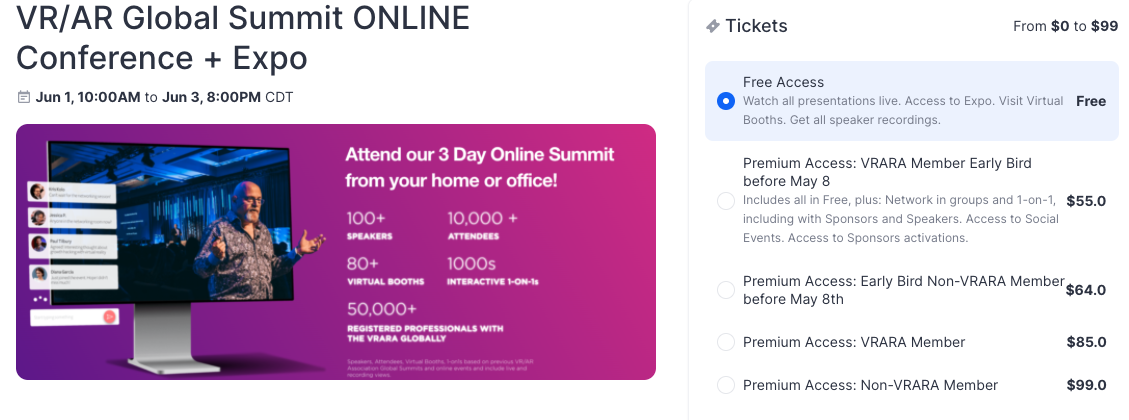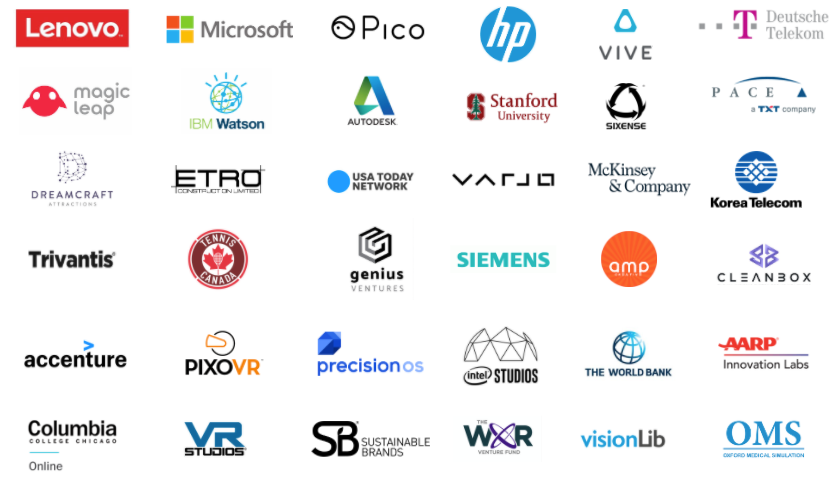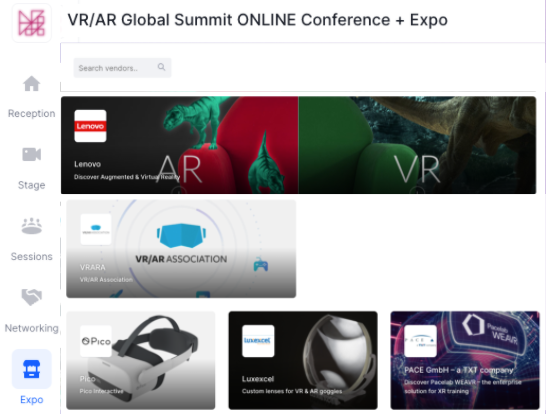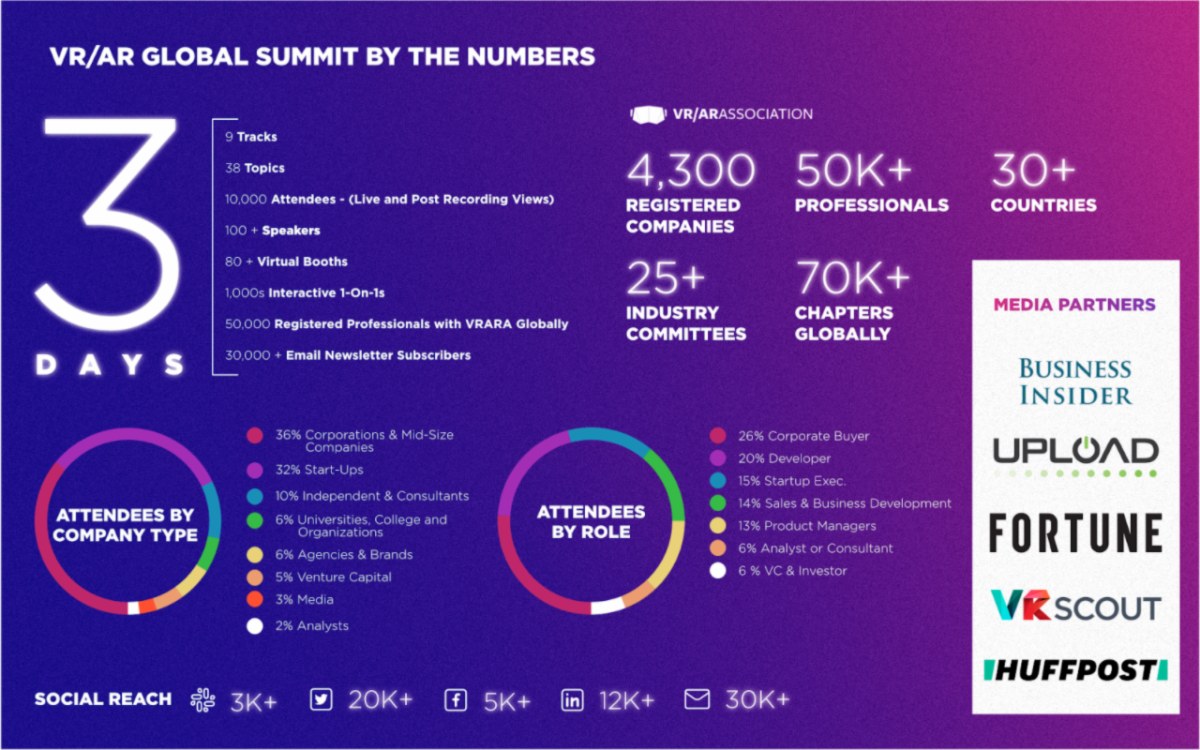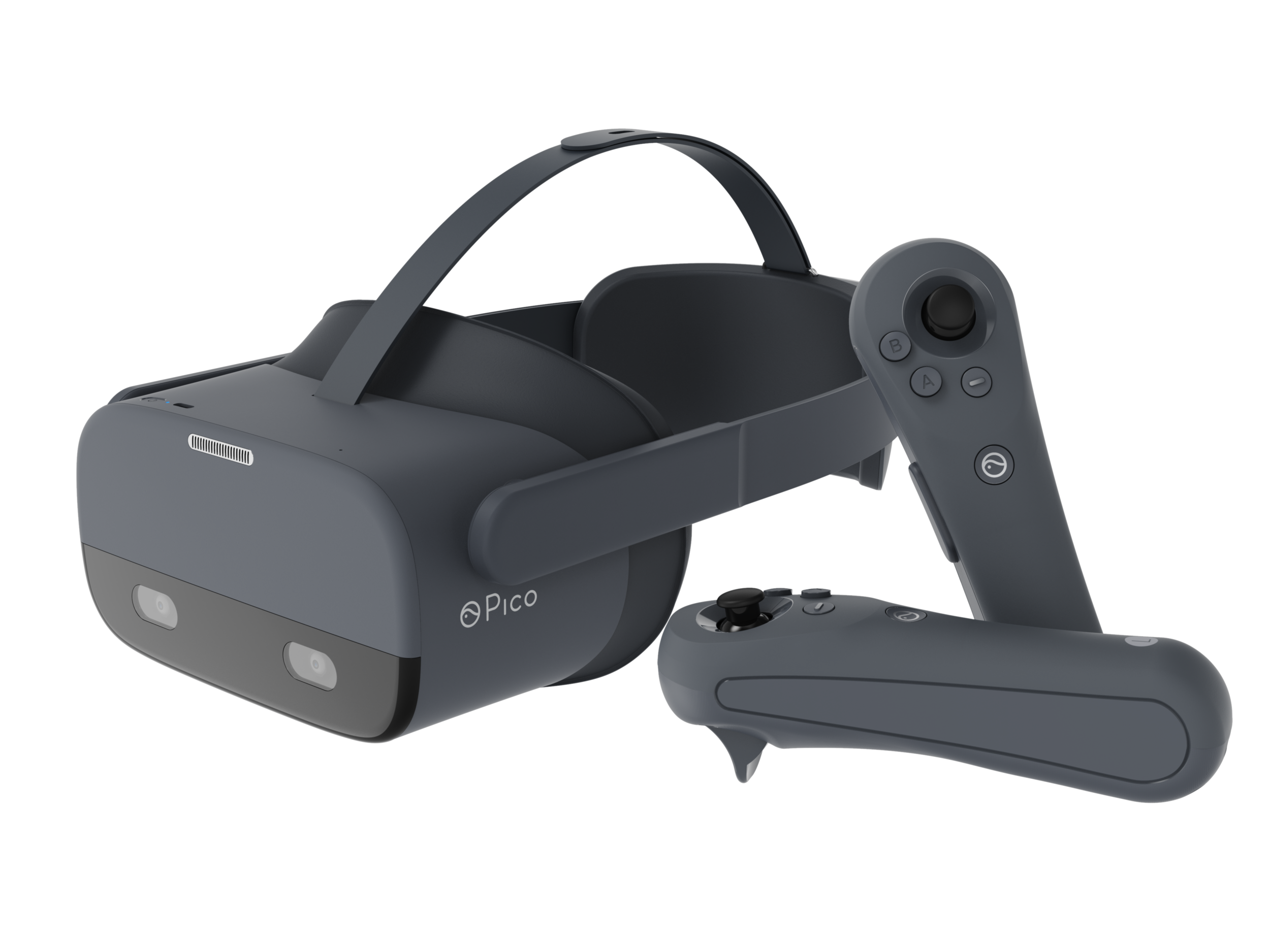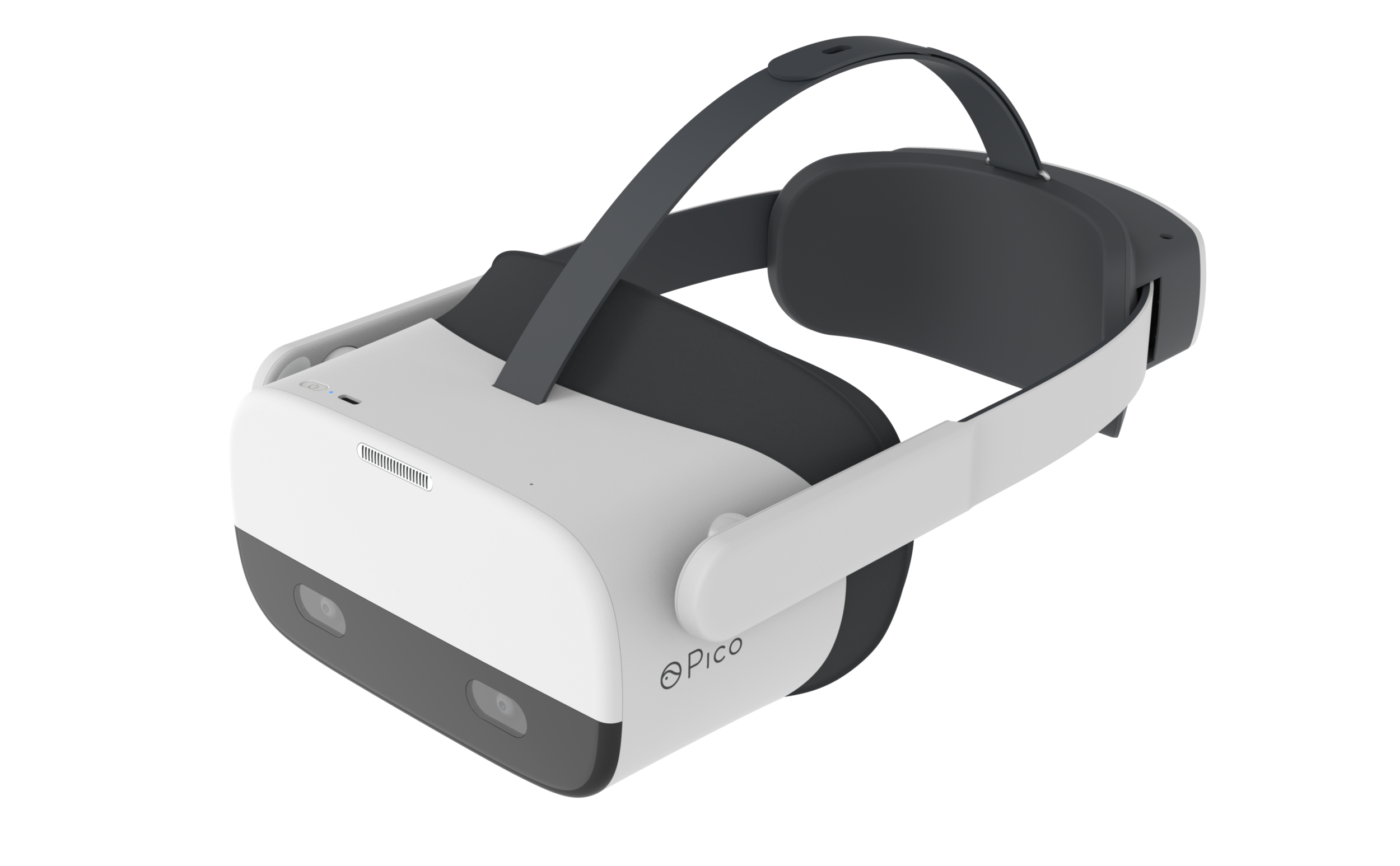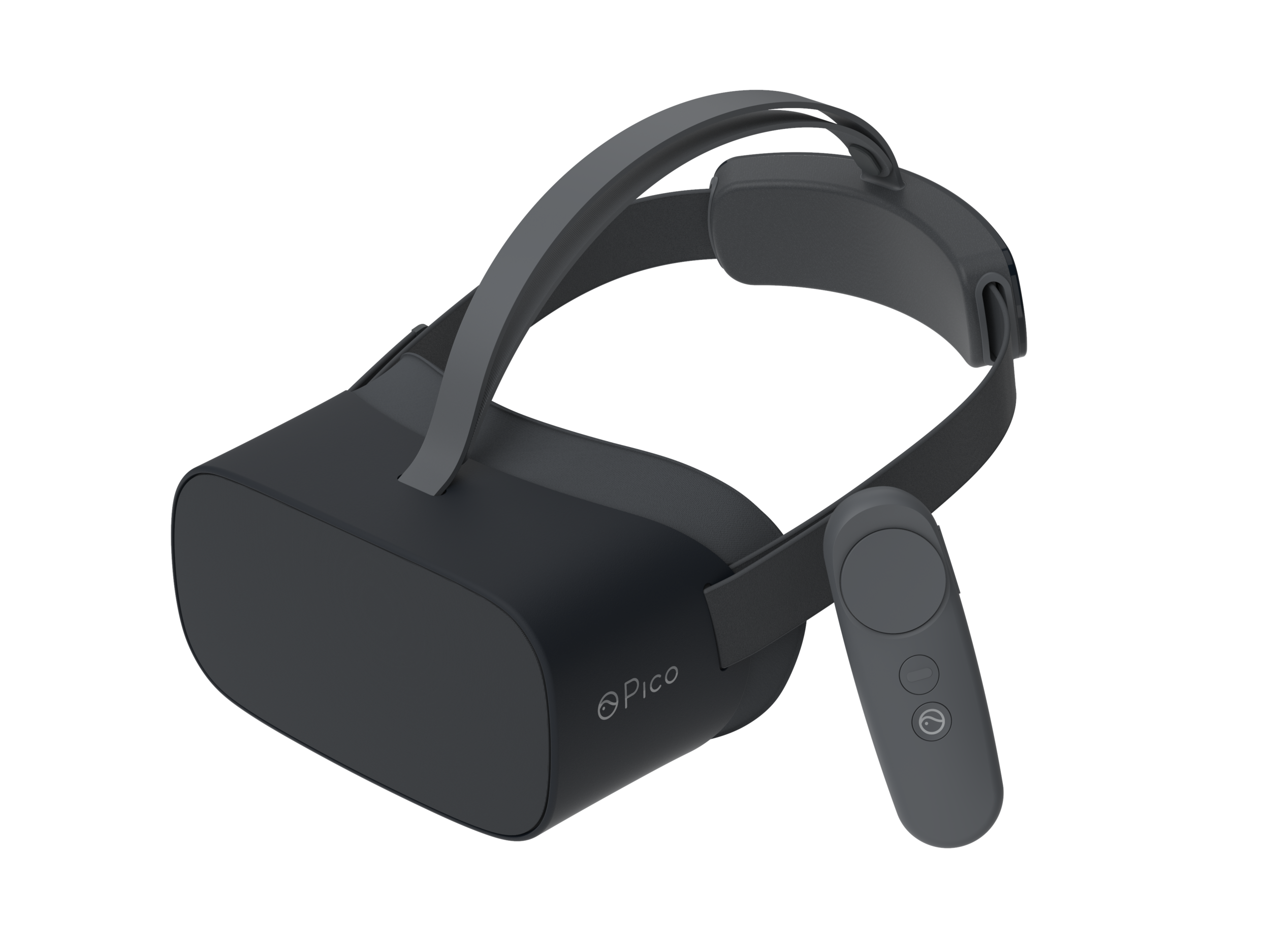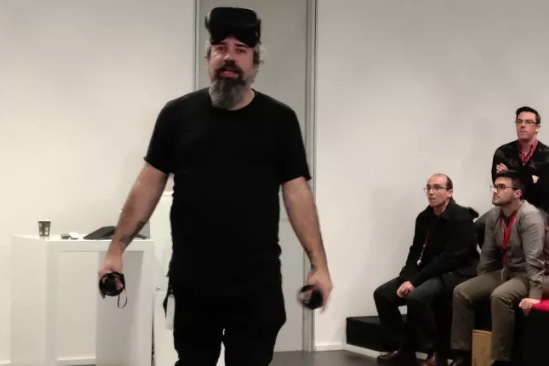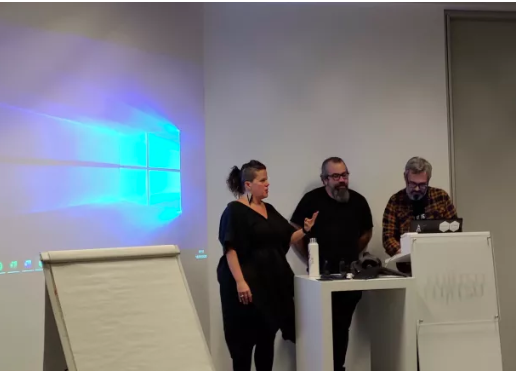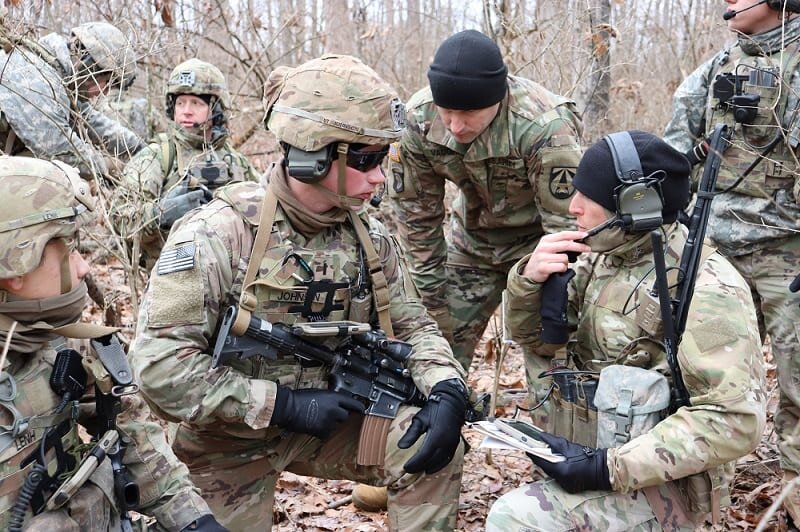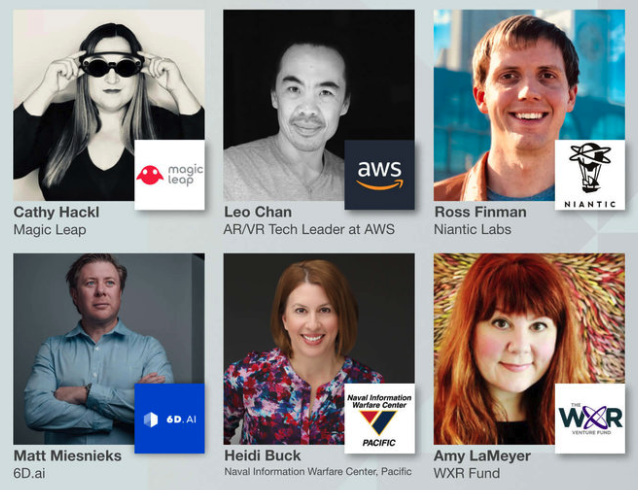Asobo Studio SARL is a French video game developer based in Bordeaux and founded in 2002. The studio has developed 17 video games, including video game adaptations of several Pixar movies, A Plague Tale: Innocence, and the 2020 version of Microsoft Flight Simulator!
World's first standard dedicated to the safety of VR and AR equipment to be presented at the VR/AR Global Summit ONLINE Sept 30-Oct 2
At our VR/AR Global Summit 2019, UL announced that it will pursue a new standard, UL 8400, addressing safety for augmented, virtual and mixed reality (AR/VR/MR) devices. The announcement was made by Ibrahim Jilani, Product Safety Director, Consumer Technologies, UL, At the event, Jilani highlighted areas of key concern including weight and neck strain, optical radiation, eye heat exposure and headset motion-to-photon latency.
At our VR/AR Global Summit ONLINE Sept 30-Oct 2, UL will speak about our COVID-19 Industry Alert and the UL 8400 standard (world's first standard dedicated to the safety of VR and AR equipment) and what’s been discussed with the standard technical panel members involved and give overview of who all is signed up to help make the world’s first safety standard for VR/AR/MR equipment such as Google, Apple, Microsoft, Magic Leap, Lenovo, HTC as well as Stanford Medical, Design Interactive, CPSC, and others.
“With the mass adoption of virtual, augmented reality equipment, balancing design and technology innovation with operational and product safety can be a challenge. UL’s goal is to keep safety in pace with innovation,” said Jilani.
As part of the UL 8400 development process, UL Standards (part of Underwriters Laboratories, the nonprofit entity within UL) is seeking equipment and component manufacturers, suppliers and others associated with the VR/AR industries to participate on the standards technical panel that will draft the standard.
IMPORTANT DATE CHANGE! The new date for our VR/AR Global Summit ONLINE is Sept 30-Oct 2
The VR/AR Global Summit is gearing up for its most incredible edition yet. Now in our 4th edition, we are pleased to bring you three days of engaging content, exciting product announcements, exhibitors, original events and networking opportunities. We are looking forward to welcoming you to our event this Fall.
In going with the theme of "Adaptability" this year, our event must follow this theme. In light of the announcement that OC7 (FC7) will take place on the same dates as our event, we have made the decision to move our event to new dates and will now host you online on September 30-October 2, 2020. We want to give our sponsors, speakers, exhibitors and attendees the ability to shine and not be overshadowed by another large event. We want the engagement of our audience to be 100% so we made the right decision to not overlap with another industry event.
We know that the VR/AR Global Summit ONLINE Fall Edition is bringing together the best of the best in the industry, new clients, enthusiasts and creators. We are welcoming speakers from HP, Lenovo, Intel, World Bank, DreamWorks, Burning Man, Lost Horizons Festival, various platforms and collaboration tools, and so much more. We will cover topics from education to medical, defense to enterprise, immersive experiences and content creation, ethics and diversity - everything that VR and AR touches in the world.
Our team looks forward to having you join us online Sept 30 - Oct 2, 2020. If you have any questions please do not hesitate to contact us at any time. We are here to help make your engagement at the VR/AR Global Summit the best possible experience.
Recent Highlights & Additions:
Sponsors - Microsoft added to the lineup that now includes HP, Lenovo, ARA, UK Trade, ATD, Innovate UK, Foundry 45, Age Tech
Online Expo - Virtual booths added for Government of Canada, Uptale, among othersDeadlines:Sept 24 is the new deadline to book your virtual boothSept 25 is the new deadline for Sponsors
Join UK's Immersive Trade Mission to our VR/AR Global Summit Online Conference and Expo
Attention UK VR/AR companies: Register to join the UK's Department for International Trade team in San Francisco (DIT SF) on its first virtual Immersive Trade Mission, 30 September to 2 October, 2020.
The DIT SF Creative and Media team will help UK mission companies sell into US companies, develop US expansion strategies, and network with high-level executives in the VR/AR industry.
The centerpiece of the mission, the VR/AR Global Summit, is one of the industry's largest, fastest growing immersive tech events, connecting the best virtual reality and augmented reality solution providers with enterprise and media entertainment companies. The June 2020 summit had 11,000+ attendees, 250+ speakers and exhibitors, and thousands of interactive one-on-one meetings and networking sessions across three time zones. DIT SF is a Summit sponsor.
Mission companies will have the exclusive opportunity to:
Have a virtual presence in the GREAT Britain booth on the virtual expo floor
Demo services and products at the summit
Arrage meetings with buyers and attendees via the Summit's meet-to-match system
Participate in DIT-exclusive breakout sessions with keynote speakers, industry thought leaders and conference attendees
Benefits of participating in DIT SF's virtual trade mission:
Be one of up to 10 companies specially selected to be part of the mission
Pre-mission briefing
Access to VR/AR Global Summit's three day event programme and associated benefits of DIT SF's sponsorship
Brand exposure
Direct engagement with in-market innovation leaders and transformative technologies
Ongoing business development support from DIT SF to facilitate export sale
Cost and Timeline:
Applications close: 21 August 2020
Companies will be notified: week of 24 August 2020
Payment of £275+VAT per person due by: 28 August 2020
Terms and Conditions:
Application to attend the mission does not guarantee selection, which is determined through a competitive review process. Acceptance is non-transferable.
Apply today at:
http://ow.ly/R7r350AXl07
See who will participate in our VR/AR Global Summit ONLINE on Sept 16-18 (brands, vendors, media, trade delegations)
We are finalizing curating the program to bring all attendees business opportunities during our VR/AR Global Summit ONLINE on Sept 16-18. See below for info on Participants and Attendee demographics. Deadline for Early-bird tickets is Aug 14 Get your ticket now! Reserve your Virtual Booth now to get the best placement in the Online Expo!
Participants in Sept
From global brands, to international trade delegations, to top companies and most innovative startups, the Summit will focus on engaging industry leaders, potential clients, and highly engaged executives.
Demographics of Attendees
By the Numbers: attendees by company type & roles you can expect at our Summit.
Testimonial
Our online summit uses a next-gen online event platform that enables different ways to interact with the attendees, including the Expo Area with Virtual Booths. Past online exhibitors got 100s of qualified leads! Book your Virtual Booth today!
Thought-provoking ‘Spatiality’ wins VR/AR Global Summit ONLINE Student Competition
At the 2020 VRARA Global Summit, 3D VR company The Wild hosted a virtual design competition, challenging its entrants to showcase their visions for the future of “digital socialization”. The challenge was to design a space that encourages “digital socialization or innovative social distancing” and examples could be the workplace of the future, an office, a public space, a lobby, entry way, room or building or other architectural space.
Six competition finalists showcased their projects during the VRARA Global Summit within The Wild virtual reality platform. Judges Aubrey Tucker (Autodesk) and Amy Peck (HTC) were present inside the virtual environment with the finalists to judge their designs from the inside. Being able to walk around their creations was a unique feature of the competition, and a delight to watch. At the conclusion of the presentations, Peck and Tucker named the winner as Spatiality – a project created by Akshansh Chaudhary.
Spatiality reflects on the Internet, privacy and safety
Chaudhary is a recent graduate of the Parsons School of Design, earning an MFA in Design and Technology. Akshansh originally designed his model using Tilt Brush and Unity and brought his model into The Wild as an FBX. Spatiality features structures representing various social networks and technology companies, and their metaphorical and physical manifestations. To Chaudhary, the project was inspired by his time self-isolating during the beginning of the COVID-19 pandemic while living in New York City.
Akshansh Chaudhary, winner of VRARA Student Design Competition
“Due to the lack of social interaction in NYC, I wanted to create a space for people to interact and engage socially, and VR has the potential to have that engagement. I was inspired by apps like Altspace VR, VR Chat, and Half Half. The architectural landscape that I have designed is stylistically organic and redefines visits to social media portals. Its design in Tilt Brush makes it a playful interactive experience.”
The floor and the outside shapes in purple are not made up of solid colors, but are layers and layers of text that include his own personal information. According to Chaudhary it includes names and information that would typically be used to exploit privacy – like relatives names and addresses and so forth. Surrounding the space is a gallery of different tech companies – including Google, Facebook and Twitter – in a “technological landscape” that demonstrates both his feelings and impressions of their roles in society and their treatment of private information. In front of Facebook there is a shady looking character which is how Chaudhary “perceive’s Facebook” when it comes to trust around privacy. Each social and tech company has a different feeling and aesthetic, with seating or viewing areas made up of components such as likes, hashtags, or strings that tie people to the technologies that they depend on.
In an interview with SPAR 3D, Chaudhary said his interest in privacy began last year when he was working on a school project on local journalism.
“Journalism is not my domain, but I was reading about fake news and how people perceive it… and as I got involved in the project, I realized that advertisements on news sites are based on infrastructure that is based on data collection – and that gradually became the basis of understanding data being collected, and what we can do as individuals to become more comfortable in understanding the use of that data.”
“As I started researching more, I realized I had to be much more vigilant about [privacy], and it led me to design an interactive experience that allows people to have conversations and create a safe platform that allows for that discussion… My design thesis was about putting people in virtual spaces and asking them to make free decisions on data privacy or data collection and seeing the result of those decisions.”
Inspired by his thesis project, he started to think about how to represent his own feelings and relationships with the social networks around him for the VRARA competition, which where ultimately shaped by his experiences during his isolation from COVID-19. He reflected that he had made Facebook quite dystopian looking, probably due to the news around the platform at the time, and Google is cleaner and feels safer in the space.
“I was starting to get comfortable with having a Google Home at home – I started talking to it more once I was isolated, I was indoors and needed someone to talk to, and it affected the landscape as I created it.”
You can watch a full tour of Chaudhary’s space is below (starts at 33:33 minutes).
Whimsical Lounge Pods earns Honorable Mention
Designed by Nicholas Peruski, Lounge Pods received an honorable mention in the competition. Taking a playful, almost Dr.Seuss-ian design, Lounge Pods models an outdoor work or break space, featuring stairs, viewpoints, and platforms that line up in pleasing curved and circular modalities throughout the space. Peruski created the space in Rhinoceros 6 by manipulating and extruding curved shapes, cutting holes, and drawing shapes. Also a New York City resident, Peruski was inspired by social distancing circles painted on the grass of Domino Park in Brooklyn, New York. The platforms, or Pods, are separated with adequate distance yet allows comfortable groups of friends and families to enjoy the company of those in the other Pods. A collection of stairs and tubes represent a series of passages and thresholds as in a quarantine or disinfection scenario.
If, like me, you are in need of something to be inspired by lately – I encourage you to take a moment to watch the video tour through all six of the competition’s excellent entries (below). The time and inspiration that these students put into their work is exceptional, and we are sure at SPAR 3D that they will be the among the visionaries defining our 3D spaces of the future.
HP Reverb G2 Announced at VR/AR Global Summit Online
HP REVERB G2
THE NO-COMPROMISE VR HEADSET
THE HIGHEST RESOLUTION VR HEADSET
AMONG MAJOR VR VENDORS1
Realistic visuals. Immersive soundscapes. Superb tracking and performance. Developed in collaboration with Valve and Microsoft, our breakthrough headset delivers a more immersive experience2. Ergonomically designed for comfort. Optimized for compatibility.
Introducing the new standard in VR.
Exceptional combination of visuals and sound
Equipped with industry-leading lenses and speakers designed by Valve, our HMD provides high-quality resolution and fully immersive spatial audio. With mura-free, 2160 x 2160 LCD panels per eye, you can now see more detail than ever before.
A headset that adjusts to you
Get maximum comfort for longer wear time. With flexible material, increased cushion size and lenses that can adjusted for different eye distances3, each user experiences a custom fit regardless of face size and shape.
More cameras. Better tracking.
With four cameras built into the headset and no external sensors required, you can now track more movement2, no matter how extreme. And with a smaller and more ergonomic design, our controllers are more natural and comfortable to hold onto.
Compatible across the industry
Looking for access across any and all VR content? With compatibility across both SteamVR and Windows Mixed Reality4, seamless access to everything VR is now within reach. All with quick and painless setup.
Links:
Z Social Media Accounts (stay connected!)
Order now!
Shipping Globally in the Fall
Pre-order now in the US
Pre-orders in select countries rolling out mid-June through July
Disclaimers:
1. Based on HP's internal analysis of companies that have shipped greater than 50,000 VR tethered headsets. Resolution based on panel pixel count as of March 2019.
2.Compared to HP Reverb G1 HMD.
3. Interpupillary distance (IPD) adjustment is included. Eye relief is not a feature of this product.
4. Windows Mixed Reality requires Windows 10 May 2019 Update installed on the workstation or PC. Features may require software or other 3rd-party applications to provide the described functionality. To minimize the possibility of experiencing discomfort using a VR application, ensure that the PC system is equipped with the appropriate graphics and CPU for the VR application. For HP workstation VR ready recommended configurations, see: https://h20195.www2.hp.com/v2/GetDocument.aspx?docname=4AA7-6063ENW
©2020 HP Development Company, L.P. The information contained herein is subject to change without notice.
Lenovo Mirage VR S3 Standalone Headset with ThinkReality Is Ready to Empower Global Enterprises and Their Workers - Announced at VR/AR Global Summit Online
Research Triangle, NC – June 1, 2020 – Today, during the VR/AR Global Summit Online Conference, Lenovo™ (HKSE: 992) (ADR: LNVGY) announced the latest addition to its portfolio of commercial virtual reality (VR) solutions — the Lenovo Mirage VR S3 headset with ThinkReality. The new VR solution for enterprise was unveiled during the keynote speech by Nathan Pettyjohn, Commercial AR/VR Lead, Intelligent Devices Group, Lenovo.
The Lenovo Mirage VR S3 is an all-in-one headset developed in conjunction with Pico Interactive, a global technology company that develops innovative VR and enterprise solutions. Specifically designed for enterprise, the Lenovo Mirage VR S3 features a 4K display for clearer visuals, hands-free control for utilization with or without the provided controller, and an easy to clean, hygienic face plate suitable for mass use. Built with integrated audio and up to three hours of battery life, the new VR headset is rugged, light weight and ready to scale within the enterprise.
Lenovo Mirage VR S3 standalone headset
The Lenovo Mirage VR S3 headset is supported by the Lenovo ThinkReality software platform. ThinkReality is among the first truly device- and cloud-agnostic AR/VR platforms enabling commercial customers to deploy and manage applications and content on a global scale, with global support. ThinkReality provides enterprise customers with powerful management tools, enterprise integration, and a robust IT portal that allows for management of user applications and devices.
The Lenovo ThinkReality platform provides a proven, scalable, and streamlined path from proof of concept to productivity for enterprise AR/VR applications. With prebuilt functions and program logic, the ThinkReality Platform enables engineers to build sophisticated applications more easily and quickly.
Using VR in the Enterprise
VR is being used in the enterprise to empower a new generation of workers by providing training scenarios in safe, repeatable environments. VR delivers immersive experiences that closely mirrors job tasks and situations so employees can gain expertise more effectively, efficiently and at lower cost.
Studies show that employees training through VR versus traditional means result in measurably higher retention rates and performance gains. From training frontline personnel to skilling up technical teams, VR offers the immersive learning experience employers need to advantage their workforce.
“VR helps achieve better, faster training at lower cost,” said Nathan Pettyjohn. “Our enterprise customers are looking for solutions to build and enable more skilled and efficient global workforces. They are increasingly looking for cutting-edge solutions like VR and AR supported by ThinkReality’s flexible platform to scale applications enterprise-wide.”
Highest Level of Support
Embedded in the new commercial VR solution is Lenovo’s latest service offering, Lenovo Integrated Solutions Support (LISS), an extension of the Lenovo Services portfolio. A standard inclusion on the Lenovo Mirage VR S3, and all solutions within the ThinkReality platform, LISS is a global end-to-end service program that supports the relevant hardware, software and services to provide an advanced level of care throughout the solution’s lifecycle. With this program, expert technicians and engineers provide hassle-free support for the entire Lenovo solution, including a dedicated phone line for quick access, a single point of contact for faster resolutions, proactive case management, and escalation assistance.
“Lenovo is placing a significant amount of resources into developing emerging business solutions to support our customers’ sophisticated needs and endeavors. These solutions require an elevated support model, like Lenovo Integrated Solutions Support, that goes beyond individual products and instead focuses on managing complex issues across the entire solution to limit downtime and create a better customer experience,” says Ganesh Raghu, Director of Lenovo’s Emerging Technology Solutions & Services.
Pricing and Availability
The Lenovo Mirage VR S3 is available the third quarter of this year in North America, China, Japan, United Kingdom, France, and Spain. For enterprise information and pricing, contact your Lenovo representative or visit our website. In North America, the price for the Lenovo Mirage VR S3 headset is under $450.
The Lenovo Mirage VR S3 headset is included in the Lenovo VR Classroom 2 education solution.
About Lenovo
Lenovo (HKSE: 992) (ADR: LNVGY) is a US$45 billion Fortune Global 500 company and a global technology leader in driving Intelligent Transformation through smart devices and infrastructure that create the best user experience. Lenovo manufactures one of the world’s widest portfolios of connected products, including smartphones (Motorola), tablets, PCs (ThinkPad, Yoga, Lenovo Legion) and workstations as well as AR/VR devices and smart home/office solutions. Lenovo’s data center solutions (ThinkSystem, ThinkAgile) are creating the capacity and computing power for the connections that are changing business and society. Lenovo works to inspire the difference in everyone and build a smarter future where everyone thrives. Follow us on LinkedIn, Facebook, Twitter, Instagram, Weibo, read about the latest news via our StoryHub, or visit our website at http://www. lenovo.com.
LENOVO, LENOVO MIRAGE and THINKREALITY are trademarks of Lenovo. PICO INTERACTIVE is a trademark of Pico Interactive. All other trademarks are the property of their respective owners. ©2020, Lenovo Group Limited.
Media Contacts
Melinda Watts – Zeno Group
+1 650-219-1823
1) All battery life claims are approximate. Actual battery performance will vary and depend on numerous factors including product configuration and usage, software, operating conditions, wireless functionality, power management settings, screen brightness and other factors. The maximum capacity of the battery will naturally decrease with time and usage.
2) Training Magazine, ‘The Impact and Potential of Virtual Reality Training in High-Consequence Industries’, Jan. 25, 2018; and Deloitte Insights, ‘Real learning in a virtual world’, Aug. 1, 2018
Get your Premium Access tickets by May 8th to our VR/AR Global Summit ONLINE Conference+Expo
Get your ticket for our VR/AR Global Summit ONLINE Conference+Expo! The event is free to attend, however, we strongly encourage you to get the Premium Access tickets by May 8th before prices increases!
The Premium Access ticket includes everything in the Free ticket, plus so much more:
Watch all presentations live
Access to the Main stage: For keynotes, live streaming, live webinars, interviews, fireside chats, and more
Access to all Sessions: For breakouts, group discussions, and meetings. Up to 500 viewers of 20 streaming participants
Access to Expo center: Visit vendor booths and demo products live. 100 booths expected!
Access to Reception area where you will receive a warm welcome and start networking
Get all speaker recordings
Access to Networking sessions
Networking in groups
Networking 1-on-1, including with Sponsors and Speakers
Access to Social Events
Access to Sponsors activations
And much more!
We want to emphasize the Networking benefit/value that comes with the Premium Access ticket: You will get to meet one-on-one and face-to-face with attendees using a special speed networking feature that will match you with the next best person available who wants to talk to you!
We already invited 50,000+ to attend! The event is 3 days, across 3 time-zones. We are all about helping you grow your business, learn, and connect. So, get your Premium Access tickets now to get the maximum value from the networking activities, features, and functionality.
Thanks!
-- VRARA Team
LAST CALL FOR SPEAKERS! VR/AR Global Summit ONLINE Conference+Expo. Deadline is this week April 15th
LAST CALL FOR SPEAKERS! Deadline is this week April 15th. If you want to speak during our VR/AR Global Summit ONLINE Conference+Expo, this is your last chance! Go here www.vrarglobalsummit.com and click "I want to Participate."
Our online event is 3 days, covering 3 time zones; it will be mega! We already invited 50,000 professionals and expect 10K+ will attend live. Topics include Enterprise, Automotive, Education, Healthcare, Fitness, and so much more!
Also,
Get tickets
Become an Exhibitor
Become a Sponsor
Go here and click "I want to Participate"
Pico Interactive added to the Sponsor lineup for the VR/AR Global Summit ONLINE Conference+Expo!
Pico Interactive Sponsors the VR/AR Global Summit ONLINE Conference+Expo
The online virtual event is taking place June 1-3
April 2, 2020. San Francisco
With operations across the globe, Pico Interactive develops innovative VR and AR hardware solutions which enable business clients to provide the best virtual reality experience in Medical, Education, Marketing, and Location-Based Entertainment industries. More info at www.pico-interactive.com
The VR/AR Global Summit Online is an online conference, brought to you by the VR/AR Association, connecting the best virtual reality and augmented reality solution providers with enterprise and media entertainment companies.
“From the Fortune 500 to startups” might sound like a really general pitch - but at the Global Summit, we really do see it all -- and we love it. Our goal is to help the industry grow and cross-pollinate.
We’ve invited people from aerospace, enterprise, health, science, real estate, advertising, manufacturing, telecom, 5G, etc.
More info at www.vrarglobalsummit.com
CONTACT
Kris Kolo
VR/AR Association
VR / AR Global Summit arrives in Europe to Lisbon. SAPO TEK interview with Anne-Marie Enns
Apply to speak, exhibit, sponsor and get tickets here for the VR/AR Global Summit Europe in Libson!!
The annual North America event expands for the first time around the world and Lisbon was chosen to speak about virtual and augmented reality!
Despite the connotation of virtual reality to video games and entertainment experiences, technology is increasingly a tool for creating technological solutions implemented in the B2B market. As technology has evolved, becoming more powerful, less expensive and freeing itself from the cables that attached them to computers, VR and augmented reality headsets are solving problems in people's lives and helping companies with their digital transformation.
Tiago Loureiro demonstrates an application that creates a virtual meeting room.
In the training area, where it is impossible to have a specialized technician to train new employees, everything can be done remotely, physically away, but virtually in the same room. And whoever speaks in teaching, it can be a qualified technician or a doctor giving precious instructions through a non-physical presence .
VR / AR Global Summit to be held in Lisbon in June
Portugal already has an association, or rather, it is one of the chapters of the VR / AR Association (VRARA), an ecosystem that brings together people, start-ups and companies to create innovative solutions in virtual and augmented reality for business application. VRARA is considered the largest association of virtual and augmented reality, with 4,500 companies, brands and schools and over 29K professionals registered. Its function is to create guides for the best practices in the use of AR / VR technology. Its members come from all areas, not exclusively technological, to support the creation of value for the community, which include meetings between producers and technology enthusiasts.
In Portugal, the association led by Tiago Loureiro, one of the Portuguese gurus in matters of virtual reality, current senior developer at Exit Games (company that created the Photon multiplayer engine); and Luís Bravo Martins, from IT People Group, promotes monthly meetings, giving the voice to its members when presenting projects and exchanging ideas and knowledge.
It was mentioned that there are more than 85 companies in Portugal creating AR / VR projects. However, Portugal is still considered a second-tier country, and therefore, according to Luís Bravo Martins, it is necessary to work to gain recognition abroad.
This week a very special meeting was held at Fujitsu's “home” in Colombo (which also has an AR solution developed for EDP), to officially announce the arrival in Portugal of the VR / AR Global Summit event that is held annually in Vancouver, Canada. The collider of the VR / AR Association and organizer of the technological event, Anne-marie Enns, was present to reveal a little more than can be expected in this first edition out of doors. The event will take place at the LX Factory during 1-2 June in anticipation of the 2020 edition of Vancouver, to be held on 17-18 September.
Anne-marie Enns, Tiago Loureiro and Luís Bravo Martins of the VR / AR Association.
Anne-marie Enns highlights the experiences that small producers and companies are doing, and 500 companies are expected to participate in this first year in Portugal. There will be a pitch contest, whose companies can register from March, with cash prizes. “We are very excited to bring this event from Vancouver to Lisbon”. The ticket price will be 199 euros for non-members, and about 99 euros for members, values yet to be confirmed. The event was scheduled to take place in Lisbon last year, but not all the necessary conditions were met, being postponed to 2020.The organization is also open to speakers who have stories and experiences about AR / VR technology. Those interested can apply, undergoing filtration, cured directly by Anne-marie Enns. Luís Bravo Martins shared his experience in Vancouver last year, highlighting the environment of uncompromised conversations, but highly focused on looking for business opportunities. There are also the so-called Speed Dates, in which the participants have an opportunity to exchange impressions, for a maximum of three minutes, with other people connected to the technology.
During the presentation in Portugal, SAPO TEK had the opportunity to talk to Anne-marie Enns about the event and the state of AR / VR technology.
What is your background and how did you get in touch with AR / VR technology, as well as the idea for the event?I was an event producer for 20 years, but in 2012 I made contact for the first time with technology in general with the production of a big hacking meet up in Vancouver. After that, I was offered a place in the production of a VR consumer event in 2016, with a company called Archiact in Vancouver, which I was connected to for two years. After that we worked to transform the event into something more focused on companies, more focused on B2B than on consumption, which is what we have been doing for the last four or five years at the VR / AR Global Summit.
Why a more focused B2B focus?
When we did the first consumer event, VR was something new. So we had about 5 or 10,000 people at the event, who had never experienced VR. The first two years were very good, but then we felt that we were dying, as it was no longer new, in addition to the fact that the content and video games were not keeping up with technological developments. So Archiact decided not to hold this event anymore, focusing only on producing VR games.
With your blessing, I took the idea and turned it into what is currently the VR / AR Global Summit, a business event. And it became very popular, even though games and entertainment were not excluded, but it also had hardware, solutions, software, immersive art, education, training, and others, covering almost the entire spectrum. In the last year we have had user cases, good practices, how to use technology to practice good actions, bringing renowned companies and organizations, such as NASA, to the event.
Do you have any idea how much the AR / VR market can currently be worth?
I don't have the exact numbers, and I don't want it to be badly recorded, but at the last event in Vancouver, we noticed a big difference with the launch of Oculus Quest, with a large number of people using and showing business user cases, because it is wireless he sees. The price of the equipment has also gone down, which facilitates its access. There are many solutions in the training area, but there are also many video game producers who have switched to the business side of training, because it is the business where the money is. They say that the industry can become multibillion-dollar and create thousands of jobs.
Do you think technology is still in its infancy?
It all depends on where you are. It is funny that Portugal has been at the level of Vancouver for five years, but much more creative. Vancouver is the second largest technological ecosystem in the world, behind San Francisco, but although it is not exempt from its problems, it has seen a large government investment. There are countries like Portugal, which are starting to open innovation hubs and train people, and to bring universities on board, so they have a greater advantage than starting from scratch.
Portugal has already started to invest and has more advantages than other companies in Europe, due to the low cost of living, innovations, and it is important to show these projects on global stages, what they have to offer. It is like the Vancouver event, which showed the world what local businesses and start-ups had to offer.
And why did you choose Lisbon for the event, it is the first city outside Vancouver?
Yes it is the first and I chose Lisbon for several reasons. The culture and innovation here is fantastic, creativity is magic. There are so many things being done here that you don't even dream of in North America, and are far ahead of other places. It is also a very beautiful destination to attract people, very appealing. There are many events taking place in northern Europe or in Germany and the Netherlands, but there is something magical happening here. There are already made products here, but also pitches with good ideas.
For you, what is the practical future of AR / VR systems?
It will be quite common when training people. I have seen it used a lot in education and in the medical field. It will be interesting to see distance training in the future, even if people need that physical contact, that's why there are mixed reality solutions. But in terms of training their jobs, systems like HoloLens have been used for more technical learning, such as defense and aerospace. In terms of culture it is very important, as I know that last year we had speeches by specialists who trained soldiers about to go into battle on cultural approach, so that they are sensitive and attentive to cultures. UNESCO has used it to showcase historical cultural sites, poverty and climate change. They’re using VR as a medium for storytelling.
What will 5G introduce in AR / VR systems?
I think it will really be a “game changer”, when we work with speeds without lag. If we have the technology, the speed and the content, we will have a perfect experience. Headsets continue to evolve, we have already reached the wireless generation, and will continue to change to be less intrusive, like smart glasses, which are easier to use.
A virtual reality experiment recently appeared, in which a mother interacted with a virtual version of her deceased daughter. Do you think that the future of VR can pass through interactive memories?
I saw it, and it really bothered me, as a mother, I think that nothing replaces the real touch, and the real emotions. I think it might work for some people as an escape mechanism, but I think it draws a very fine line, and I was not comfortable seeing that experience. I don't consider this to be a great innovation provided by VR. Brain surgery is an innovation, not this. This bothered me, ethically.
Top Ten Announcements from this year's VR/AR Global Summit
Forbes has written that our Global Summit is “one of the year’s most anticipated conferences”. Well, having travelled to Vancouver for the 2nd edition this year I was just blown away. From attendees to speakers to exhibitors, this gathering lives up to our mission of educating, connecting and promoting our ecosystem!
So without further todo here is my Top Ten list of announcements at #VRARGS
Lenovo launches their developer program for ThinkReality and A6 headset with inaugural workshop.
While Niantic couldn't make it official at the Summit and only hinted at some big news, you can see the results of their first Beyond Reality Developer Contest
XRSI's Enterprise Level Information Security Framework for the XR domain coming in Q1 2020.
Launch of the VRARA Women’s Committee with DC Chapter VP Sophia Moshasha and Global Summit Producer extraordinaire Anne-Marie Enns to helm it.
The Vancouver office of Microsoft introduce their in-house on-the-job training application for Hololens 2 that is fully-integrated with their Dynamics 365 CRM/ERP platform.
EPIC & VRARA sign MoU for industry collaboration on immersive hardware standards and advisory mandates.
Cathy Hackl joins Aurea Award Jury for immersive tech entertainment award at Europa Park in January.
6D.ai to launch AR Cloud app on iOS. Register for with Apple Testflight to get beta access already
8th Wall launch a brand new WebAR cloud editor and hosting web app.
World Bank showcase their immersive safety initiative for Latin American schools. Image below, but not official online links yet…
Jimmy Vainstein from the World Bank onstage
RECAP: The VR/AR Global Summit Featured Applications in Every Industry. And, what's next for the Association
The most exciting developments in virtual and augmented technologies from the VR/AR Association’s two-day global summit in Vancouver, BC
VANCOUVER,BC, Nov. 07, 2019 (GLOBE NEWSWIRE) -- In the second-largest VR/AR ecosystem in the world, the final day of the VR/AR Association's Global Summit saw the launch of an international women’s committee dedicated to closing the industry’s gender gap, the successful test of airborne virtual and augmented reality for military training purposes, leaps forward in health and security, and much more.
“Virtual, augmented, and mixed reality technologies are relevant to every facet of the world as we know it. The technologies being created in this space have far-reaching impacts on the workforce, health, art, entertainment, sports, national defense, and more. The importance of virtual, augmented, and mixed reality simply can’t be overstated,” said Nathan Pettyjohn, Founder and President of the VR/AR Association and Commercial AR/VR Lead at Lenovo.
Virtual reality is officially in flight
The US Air Force and Navy are increasingly leveraging advances in virtual and augmented reality to train their troops. During the summit, Red6 announced the first-ever successful execution of an airborne multiplayer AR experience. This prototype was created for the US Air Force, enabling pilots to use augmented reality to simulate and respond to threats in the air. Watch the demo video here.
Meanwhile, Heidi Buck, who heads up the Battlespace Exploitation of Mixed Reality, shared how the US Navy is using virtual reality tools for defense training and cultural immersion -- saving lives on the frontlines.
How 5G is going to make VR and AR accessible at any time, and any place
Rapid advancements in network technology like 5G and Edge Computing are changing the way we experience immersive technology. Terry Schussler, Senior Director of Spatial Computing at Deutsche Telekom, shared how we can defeat what he calls ‘the mobile zombie apocalypse’ – a term he uses to describe the increasing number of people looking down at their phones to participate in AR experiences (think Pokémon Go or Google AR Objects). Instead, what becomes available with this technology are lightweight pieces that allow users to be constantly connected, seamlessly moving between reality and AR – ultimately creating a safer and more aware society.
Augmented reality makes the world an art gallery
Artist Nancy Baker Cahill can hang her art anywhere in the world using augmented technology. Her desert installation, “Revolutions”, depicts the impact of human interference with the natural environment, whereas her series “Battlegrounds” in New Orleans uses technology to commemorate historically significant sites. This unprecedented body of work is a truly innovative application of virtual and augmented reality, making art accessible to anyone with a smartphone.
First-ever Women’s Committee launched
Announced over a session hosted and dedicated to women in VR and AR was the VR/AR Association’s Women’s Committee – dedicated to identifying, encouraging, and empowering women in the traditionally male-dominated industry of VR and AR. The Global Summit committed to a 50% female speaker roster, including the likes of Heidi Buck from the Battlespace Exploitation of Mixed Reality, Cezera Windrem of AARP, and Cathy Hackl of Magic Leap. Cathy Hackl, the #4 Top Tech Voice on LinkedIn, took the opportunity to unveil her personal commitment to empowering women in the space through a fund she has developed to invest in women, offering to cover one VR/AR Association membership, as well as personal coaching from her for a year.
Why did an VR/AR design company partner jump into the world of cannabis – and what did they learn?
Cannabis companies are embracing mixed reality as a solution to overcome certain barriers (like the fact that customers can’t handle the product and that it’s tough to transport the product over state lines) and to give both consumers and investors an inside look at their products, processes, and facilities. PATIO demonstrated how they’re solving several pain points with custom-made tools, and disrupting both industries in the process.
What’s next for the VR/AR Association
Following the successful summit, the VR/AR Association has just announced a number of newly formed committees to accelerate the market’s best practices, guidelines, and standards, as well as their plan to implement projects to further explore the vast, and potentially life-changing applications that this technology can have.
Privacy & Security Committee: Although virtual, augmented, and mixed reality products and content are becoming more widely available to consumers, there is no industry-wide regulatory or safety standard. This is why the VRARA has formed its own Privacy & Security Committee.
VR for Good Committee: In the increasingly interconnected global community, VR can instigate massive change. Jimmy Vainstein, Interactive Media Program Lead at World Bank, will co-chair a committee on VR for Good.
Sports Committee: Co-chaired by Tyler Wilson, the Director of Strategic Partnerships and Innovation at the Vancouver Whitecaps, the committee will look to push new boundaries in sports through the application of VR and increase the visibility of ESports in the wider community.
About VR/AR Association's Global Summit
The VR/AR Global Summit will bring together industry frontrunners from around the world to discuss the present and future of immersive technologies. This world-class summit will welcome 1,000+ Executives, 120+ Speakers and 50+ Exhibitors from leading companies like Lenovo, Niantic, Microsoft, Viacom, and so many more.
To learn more about the VR/AR Global Summit, please visit: https://www.vrarglobalsummit.com/
To learn more about the VRARA, please visit: https://www.thevrara.com/
Contact
Kris Kolo, Global Executive Director
Recap of VR/AR Global Summit by the Halldale Group and MS&T Magazine: VR/AR for High-Risk Sectors
By Marty Kauchak
The VR/AR Global Summit in Vancouver is called “one of the year’s most anticipated conferences” by Forbes magazine. Halldale Group Editor Marty Kauchak ventured to the Canadian coastal city to mingle with the international cross-section of thought leaders and developers.
The VR/AR Global Summit offered something for just about every industry: entertainment, sports, healthcare, manufacturing, music, oil and gas, telecommunications, tourism, training of various workforces, even poverty-reduction initiatives. And, of course, the latest hardware and software advancements from tech companies large and small.
The HoloLens2 will be used in the US Army IVAS to help soldiers communicate and coordinate during combat scenarios. Image credit: Microsoft.
There were several defense and aerospace-focused presentations. The most notable a panel on “Immersive Trends in Defense.”There was agreement on the panel that, today, following a four to five-year period of rapid protype development, proofs of concept and testing, a steady rate of initial deliveries and follow on deployments are finally integrating AR/VR into high-risk programs.
Randy Brown, Vice President, Division Manager in the Virtual Heroes Division of Applied Research Associates, noted his company is working on the US Army’s Integrated Visual Augmentation System (IVAS) – the new soldier system to be fielded with an AR capability. The overarching IVAS contract was awarded to Microsoft, with the prototype capabilities enabled by HoloLens2. Brown called attention to the need for the Service to also “integrate many different sensor platforms (night vision goggles, thermal, others) for this to be used as a true visual system.” This effort continues ARA’s decade-long effort with US DoD’s DARPA to build and license a suite of algorithms to support accurate head-tracking and registration, and symbology rendering for dismounted soldiers.
Brown pointed out the challenges to providing immersive technology to the military customer. A short list of impediments includes very restricted networks in terms of low bandwidth and other attributes. Brown also called attention to the military’s focus on SWAP (size, weight and power) when designing VR and AR headsets and related materiel. “For the military to adopt something with a VR or AR capability, it must satisfy the SWAP requirement.” The returns on investment for the customer and supplier is significant when using VR/AR, such as taking hardware into the field to a forward operating base. Indeed, ARA is working on a program to deliver a downrange virtual tactical operation center. “We’ll need enough visual fidelity to have a usable experience there; I think we’ve achieved that,” he concluded.
Applied Research Associates is currently working on the US Army’s Integrated Visual Augmentation System – the new system for soldiers (above) to be fielded with an AR capability. Image Credit: US Army/Kathy Bailey, PEO C3T public affairs.
Jason Radel, Chief Scientist at Dorval, Quebec-based Imagine 4D, indicated one of his team’s most interesting projects is the creation of a “digital twin” of a nuclear facility. Radel explained this effort is leading to the creation of a 3D model to support training and added, “We’re also doing 3D scans to make sure it is photo-realistic.” He emphasized the imperative to deliver a digital twin product – a perfect representative of reality – which will allow the facility’s workers to safely train and work. “Nuclear plants are giant in size, complex and easy to get lost in. You can’t have workers being exposed to radiation while they figure out where they are.”
The company is bringing to bear its Station IX large immersive dome to allow the project team to visualize its data. “Instead of projecting an image on a wall and viewing it directly, we’re actually projecting the image on a screen close to the user and viewing it once it is reflected – there’s a lot of optics in doing this properly. But this gives us real, 3D depth projection.”
Dean Hoover, Systems Engineer at Raytheon, noted one of the biggest challenges to implementing VR/AR in the US military has been culture and an initial hesitancy of some senior leaders who are unfamiliar with the technologies to embrace them. Hoover noted that as senior-level uncertainty and lack of knowledge have been overcome, “the biggest challenge has been keeping up with demand!”
Tyler Gates, Managing Principal at Brightline, noted, “The economy of immersive technology is by and large cheaper, over the long term, [compared to hardware-based systems] because you can create specialized, specific content inside head-on displays, some of which you can buy at a box-store for $200-$900.” He concluded, “When compared to the more expensive cost of comparable hardware, the cost-benefit analysis in favor of AR/VR is further pushing the culture shift away from the legacy product solution. It’s about building software platforms that can scale.”
Vive Pro Eye HMD gets visual clarity boost with Almalence Digital Lens add-on
Vancouver, Nov 1. VR/AR Global Summit
Today at the VR/AR Global Summit, Almalence announced a Unity plugin implementing its Digital Lens technology, dramatically improving the visible resolution and picture quality of VR head-mounted displays. The plugin is designed for Vive Pro Eye HMD and is freely available to the VR application developers.
Almalence Digital Lens is a computational technology overcoming the limits of HMD optical performance. Using eye tracking data along with a measured profile of lens aberrations, it increases the visible resolution and removes chromatic aberrations across the entire field of view, at any gaze direction. It does a job of a corrective optical element while adding no extra size or weight to the HMD device.
It is commonly accepted that picture quality and visual fidelity are crucial factors for a truly immersive VR experience and for VR adoption in general. Few realize though that simply increasing the display pixel count is not enough, because not only does it matter what the display shows but what the user can see, and the quality of the visible picture is actually limited by the fundamental constraints affecting the optical performance of HMD lenses, namely a moving lens element (eye pupil) and overall size constraint, limiting the complexity of the optical system.
Limited HMD optical performance is the main reason why the substantial increase of display resolution in HTC Vive Pro over the original Vive did not bring much of a visible improvement. Implemented as a software plugin for Vive Pro Eye, the Digital Lens literally makes the Vive Pro’s high resolution visible.
“It is common now to compare VR head mounted displays to the computer displays of the 70’s or 80’s. Digital Lens removes a fundamental roadblock on the way for VR HMDs to achieve the visual clarity matching XXI century standards,” said Eugene Panich, CEO of Almalence. “We are excited to make this technology directly available to the app developers, allowing to provide higher picture quality experience to their users immediately without waiting for the technology to be adopted by the HMD OEMs, and to gain additional value from investment in eye tracking hardware.”
More information is available at almalence.com/hmd-technology
About Almalence
Almalence is the global leader in computational imaging technologies, useable in a wide range of optical systems, from high-end DSLR cameras to mobile phones. Their customers range from the top smartphone OEMs to millions of users of camera applications. Almalence is an Intel Capital portfolio company.
Contact info
Tyler Wilson, Director, Strategic Partnerships and Innovation for the Vancouver Whitecaps will host Day 2 of the VR/AR Global Summit!
Tyler Wilson is the Director, Strategic Partnerships and Innovation at the Vancouver Whitecaps FC, where he creates strategic partnerships that empower the Club to push new boundaries and drive revenue. He does this by strategically integrating partners and utilizing tech to create rich interactions.
Currently exploring ways to maximize connectivity with immersive experiences across Club development platforms. With over 40,000 athletes nationwide, it represents the largest development arm of the sport in North America. Also exploring ways to grow our emerging Esport platform in a unique fashion.
Tyler Wilson Bio
An avid AR/VR fan, experienced CRO in the Blockchain space and industry leader with over 15 years experience in the sports and entertainment sector. He’s been printed in the Sports Business Journal and presented on a global stage for the innovations and partnerships he’s created. Going outside the box and looking how tech can solve problems has allowed Tyler to push new boundaries throughout his career.
Tyler is proud to be Director of Strategic Partnerships and Innovation for the Vancouver Whitecaps FC, an advisor on Esports with the Vancouver Economic Commission and the luckiest dad is the world!
Day 1 of the Summit will be hosted by Jesse Damiani of VRScout!
See Schedule vrarglobalsummit.com/schedule
Get Ready for VR/AR Global Summit (Video Roundup). See this video and narrative analysis/takeaways, care of Mike Boland of AR Insider
To get the juices flowing for the VR/AR Global Summit that kicks off late newt week, we’re looking back at all of the great knowledge shared at last year’s event. As a teaser for what you can expect in Vancouver starting late next week, below is video and narrative analysis/takeaways, care of AR Insider.
We hope to see you at the event, and it’s not too late to register. There will be lots of knoweldge and networking to gain if last year’s video footage is any indication. Here’s the video roundup from last year’s show:
Enterprise AR Should start Small and Stay Focused (Atheer & Telus)
Atheer executed a successful AR program with Porche. But such results require client readiness and focused pilot programs for technical and business validation. Don’t boil the ocean, the company says: Start with one use case and make it successful.
Read more here and see the video below.
Who Owns Your Augmented Reality (Timoni West)
In all the excitement around our spatial future, relatively few people discuss nuanced realities like privacy and control of augmented spaces. What filters will we have to activate AR layers... or deactivate them? Unity's Timoni West breaks it down.
Read more here and see the video below.
An Operating System for the Physical World (Matt Miesnieks)
The AR cloud could be a sort of operating system for the real world, says 6D.ai's Matt Miesnieks. This would offer spatial understanding of the physical world through 3-D mesh data and contextual recognition of people, objects and motions.
Read more here and see the video below.
What’s Working in LBVR (Joanna Popper)
Location-based VR has pros and cons. It’s primed for early-stage VR when consumers aren’t ready to own hardware. But the unit economics can be difficult (just ask IMAX) in terms of yield, throughput and fill rates. Joanna Popper breaks it down.
Read more here and see the video below.
How Will Amazon Democratize AR Creation (Kyle Roche)
One way to accelerate XR adoption is to lower barriers to entry. That's the rally cry of Amazon Sumerian. GM Kyle Roche says the goal is to accommodate a range of personas and technical skills within the brands that will be XR’s first adopters.
Read more here and see the video below.












